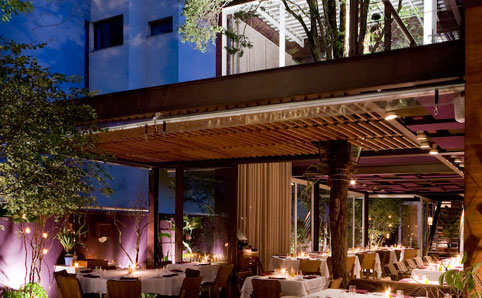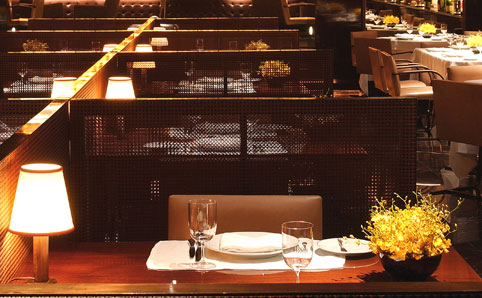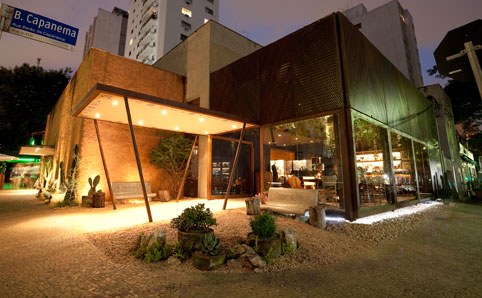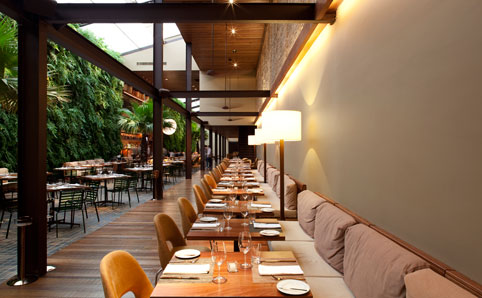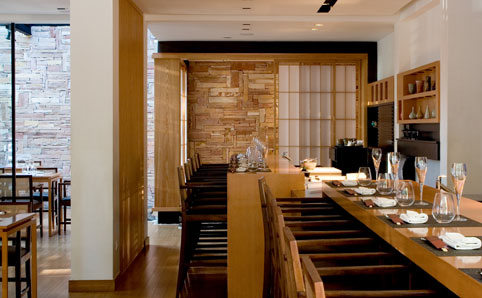
Alma María | Dui | Fasano | Dalva e Dito | Kaá | Kinoshita
'Ready to order?’ Who, us? Transfixed by the exuberant mass of green behind us – a living wall 70 metres long, crammed with more than 7,000 plants – we’ve neglected to pay any attention to the menu at Kaá.
This soaring, thrilling space is far from being São Paulo’s only drop-dead gorgeous restaurant: for a certain section of São Paulo society, eating out is an obsession, and there’s a whole cast of beautiful dining rooms that elevate the drama of dining to dizzy heights, from the immense windows exposing the inner workings of the kitchen at Dalva e Dito, to the opulent elegance of the Fasano, inside the eponymous hotel.
But we’ll come clean: Kaá, which won best new restaurant at Wallpaper* magazine’s 2010 design awards, is still the city’s number-one beauty for us. And it’s complemented, as all good restaurants are, by excellent service; and by chef Pascal Valero’s simple, sublime Franco-Italian cooking.
Kaá’s much fêted architect, Arthur Casas, who has offices in São Paulo and New York, has an impressive track record in restaurants, having also designed Kosushi, Cantaloup and most recently Alma María, whose magnificent carved hardwood doors opened up on chic Rua Oscar Freire at the end of 2011 to reveal a voluminous split-level space accentuated by vibrant colours.
Culinary comings and goings
It’s just one amongst many in a recent flurry of high-profile openings, part of a never-ending carousel of gastronomic comings and goings. And yet where one door opens, another one closes: for every five restaurants that opened in São Paulo state in 2011, another one closed, according to the Brazilian Association of Restaurants and Bars. But that doesn’t stop restaurateurs from aiming ever higher and spending ever bigger money to win over the city’s discerning diners.
With competition hot, restaurants need to get the formula just right. For Arthur Casas, that means stimulating all the senses. ‘The music is important. The cutlery, the crockery, the space, the overall look – they’re all just as important as the food. Particularly in São Paulo,’ Casas says, ‘where people don’t go out to a restaurant to eat; they go to be entertained.’
Lunchtime, in Casas’s opinion, is the ultimate test of a restaurant. ‘Anyone can create a nice atmosphere in the evening by lighting a few candles. But it’s much harder to create an atmosphere that works during the day. If a restaurant can do well at lunch, it will work for dinner too.’ Kaá, a case in point, is undoubtedly best experienced at lunchtime, when – besides the bonus of a more affordable set lunch menu (R$56) – daylight filters through the retractable glass roof, flooding the space beneath it to glorious effect.
The devil is in the detail
Detail, detail, detail is another mantra of the city’s elite restaurant designers. Every aspect of the apparently simple Kinoshita was meticulously planned to incorporate all the elements of a traditional Japanese home. ‘Architecture isn’t just about the building,’ star architect Isay Weinfeld told us in an interview back in 2010. ‘I could never take on a project like the Fasano hotel if it were only to design the building or the interior. I design everything, down to the ashtrays.’
Casas has a similar approach to his projects, designing or picking even the smallest details, like the rainbow-coloured rows of products, from jars of soap to tins of paprika and label-less ketchup bottles, that adorn the entire wall of shelves at Alma María in blocks of bold colour. ‘It’s not about how much you spend,’ says Casas. ‘It’s your capacity to transform a space into something interesting.’
Casas rates Maní highly, for example, precisely for its simplicity: diners at the contemporary restaurant sit in the white-washed interior of a former house. ‘Maní has a nice presence, a lovely soul. It’s simple and chic.’
For the city’s hottest architects like Casas and Weinfeld, whose practices are founded on a solid base of commercial projects and residences for the city’s elite, show-stopping restaurants are just the icing on the cake, and the chance to earn critical acclaim and international recognition.
But the risks are high, too. A good restaurant is far more than just a pretty face, and stands or falls on a thousand different variables. Mastering the exact alchemy for success will make or break budding restaurateurs, and Casas is suitably cautious. ‘I’m wary of doing projects for people with no background in running restaurants. Because if the project should fail, people blame the place and not the food or the service.’ Read on for our roundup of some of São Paulo's most stunning eateries.
Alma María (restaurant closed in June 2012)
Rua Oscar Freire 439, Jardim Paulista, 3064 0047, almamaria.com.br
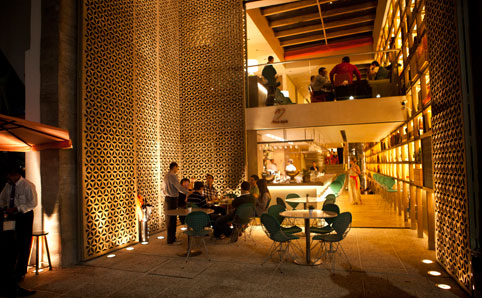
- Architect Arthur Casas
- Where to sit Downstairs in the cool during the day, and up by the terrace at night
- What to eat Vitelo Tonnato – veal carpaccio with tuna sauce, capers and eggs
- Don’t miss The Redujito – a sherry-based mojito
After two years in the making this bold temple to tapas opened its striking 20-foot-tall carved wooden doors onto chic Rua Oscar Freire at the end of 2011. Alma Maria, the latest restaurant by the architect Arthur Casas, is a statement of colour and space – it’s design that wants to be noticed. And it works.
The first element to hook the attention of potential diners is undoubtedly the doors, Casas’s own favourite detail. Vast, hefty Moorish-style carved slabs that open fully outwards, they remove any delineation between restaurant and street. ‘The floor at the entrance is in the same material as the pavement,’ says Casas ‘precisely so that diners can't tell where one ends and the other begins.’
All eyes – and hungry passersby, lured in from the street – are drawn in down a corridor between a long bar and the start of a patchwork of 320 shelves that stretches the length and height of the restaurant. Where to sit? Head down the steps to the cool, cosy basement, up to the mezzanine suspended in a huge volume of space, or further on up to the top, where a terrace looks out over the street as well as up and out through the restaurant’s skylight.
Everywhere you look, vibrant colours and textured stone contrast with a blocky concrete finish. And wherever you sit, the immense stack of boxy shelves is a constant, packed with a general-store-style rainbow selection of produce – bars of coloured soap, yellow tins of chilli powder, white jars of coconut milk, and red squeezy Heinz ketchup bottles (minus branding), to name but a few.
On the menu, the bite-sized ‘montaditos’ – sharing tapas and main courses from different regions of Spain – match the space in their immaculate presentation. This is tapas without the spit and sawdust of Spain, and with all the glamour (and price tags) of chic São Paulo.
Dui (restaurant closed in May 2013)
Alameda Franca 1590, Jardim Paulista, 2649 7952, duirestaurante.com.br
- Architect Renovation by SuperLimão Studio
- Where to sit At the round table beside the back courtyard, for the best view
- What to eat Push the boat out with the 12-course supper club – ‘Clandestino’ – on Thursday nights
- Don’t miss Glimpses of the surrounding bustle in the mirrored tables in the bar
Light, lush and permeated with shades of regal purple, Dui’s retro interior does its utmost to channel the building’s former resident – a plant nursery. Enjoy the curious sensation of not knowing where the inside ends and the outside begins as you wander through the long, narrow interior.
Glass pervades here, from the ceiling above the double-storey dining area to all the exterior walls. Look again and you’ll notice that in certain parts there aren’t any walls at all, with the restaurant spilling out onto open-air courtyards. The city might be within arms’ reach, but the urban chaos stays firmly shut out by towering trees, some of which are rooted right inside the restaurant, growing up through the glass roof.
Natural light fills the space during the day, while at night, candles hanging in the trees give a dash of secret-garden romance. In the bar, Scandinavian-style chairs, striped rugs and large lampshades in concentric circles are just a few of the 1960s- and ’70s-style furnishings that lend a vintage touch. Soak it all in while – if you get your timing right – you sip a caipirinha made with fruit straight from the trees (jabuticaba, pitanga, and uvaia).
Bold purples permeate without being opressive, from the walls to the napkins. Look up and you'll see a jigsaw puzzle of graphical foam blocks on the ceiling – an innovative solution by the restaurant's architects, SuperLimão Studio, to the acoustical challenge of the din of diners with so much glass and concrete.
‘The colours transmit elegance and intimacy,’ says the chef Bel Coelho, one of the stars of São Paulo’s restaurant scene. Coelho’s food is eclectic and creative, with touches of French, Spanish, Portugese, Italian and Brazilian cuisine.
Fasano
Rua Vittorio Fasano 88, Jardim Paulista, 3062 4000, fasano.com.br
- Architects Isay Weinfeld and Márcio Kogan
- Where to sit Isay Weinfeld likes the first table on the left, while Mr. Fasano prefers the opposite table on the right. You read it here. Now get in line.
- What to eat Duck ravioli with an orange sauce
- Don’t miss The frosted window on the way to the bathroom. Press the button and the kitchen is revealed.
The ‘wow’ of the Fasano restaurant comes as more of a gentle crescendo than a fortissimo bang. It starts when you walk into the lobby of the eponymous hotel, the polished woods, brown leather armchairs and floor-standing lamps exuding quiet, unassuming sophistication.
It builds as you head past the baby grand piano through the bar to the steps leading down to the restaurant. And there it unfolds in glorious splendour – a grand atrium awash with black marble and dark wood in an unmistakeable, classic 1930s style.
Created by the architects Isay Weinfeld and Márcio Kogan, the studious attention to detail here covers everything from the furniture – Weinfeld is reported to have made eight overseas trips with the owner, Rogério Fasano, to source the perfect pieces – to the lighting: a large, retractable skylight lets natural light in during the day while in the evening, uplights on the wall and art deco tabletop lamps make for an intimate feel.
Dalva e Dito
Rua Padre João Manuel 1115, Jardim Paulista, 3068 4444, dalvaedito.com.br
- Architect Marcelo Rosenbaum; renovated by José Roberto Moreira do Valle
- Where to sit By the kitchen window for front-row seats of the action
- What to eat Pirarucu (freshwater fish) with ratatouille do sertão – a mix of Brazilian veg like plantain, chuchu and sweet potato (R$51)
- Don’t miss The ‘indigenous wall’ – an exposed patch of adobe wall
If you can’t wait weeks to get a table at Alex Atala’s critically-acclaimed D.O.M., you’ll find just as many grand gestures going on at its sister establishment, Dalva e Dito, just half a block away. The food is simpler and the vibe more informal, but the inspiration is the same: a celebration of the best of Brazilian food and culture.
A renovation by José Roberto Moreira do Valle at the start of 2012 has added a touch of transparency to the tall box of a dining room: the addition of a glass-walled bar, which doubles as the new entrance. It’s a sensory overload from the get go, with all the spectacle of a theatre set. Plants snake down from the ceiling of the bar, tin gas lamps top the tables, and pieces of popular Brazilian art create plenty of interest.
An entire wall of blue-and-white tiles – one of the last projects completed by the painter and sculptor Athos Bulcão before he died – greets diners in the main space. The focal point, however, is the floor-to-ceiling window, which looks right in on the chefs at work in the kitchen.
The earthy tones of the walls, the unpolished tables fashioned from reclaimed wood, and the wicker-backed chairs that look straight out of a colonial mansion, are a comforting balance to the grandeur of the high ceilings. Big groups should book the centre table – it’s a large, round table that seats ten, with one of the laziest lazy Susans we’ve ever seen – you’ll need to flex some serious muscle to move it.
Look out for quirky details like the ceramic chickens, the bunch of coconuts adorning the central table – last month it was bananas – and the form of a lady set in the middle of a Wilma-Flintstone-style set of giant rosary beads on the wall.
Kaá
Avenida Juscelino Kubitschek 279, Vila Olímpia, 3045 0043, kaarestaurante.com.br
- Architect Arthur Casas
- Where to sit Near the bar at lunchtime, to get the best light and avoid the kitchen rush
- What to eat Lobster sausage with vermouth sauce and a leek compote
- Don’t miss The ‘water mirror’. Actually, do miss it. Unless you're wearing wellies
Avenida Juscelino Kubitschek, with its eight lanes of traffic, might be the last place you’d expect to find one of the city’s most tranquil restaurants. But behind an anonymous white wall lies a veritable Garden of Eden. Narrow and tall, the dining space at Kaá is dominated by a spectacular 8m-high and 70m-long wall covered in more than 7,000 plants native to Brazil’s Atlantic forest.
Architect Arthur Casas’s aim here was to transport the diner away from the urban chaos: once inside, there’s no visual connection with the city outside. Natural materials and neutral colours comprise every fixture and every fitting, making an aesthetic antidote to the exuberant vegetation, with the overiding sensation being one of calm and space.
The retractable roof is sometimes opened (if the aircon addicts don’t get hot under the collar). For a more cosy experience, the mezzanine box affords a prime view over the vertical garden. Much lauded since it opened in 2008, this gorgeous urban oasis is the very epitome of tropical-modern chic.
Kinoshita
Rua Jacques Félix 405, Vila Nova Conceição, 3849 6940, restaurantekinoshita.com.br
- Architect Naoki Otake
- Where to sit At the counter, to watch chef Murakami and team in action
- What to eat The daily-changing 11-course kappo tasting menu, for full immersion (R$290)
- Don’t miss The saké collection under the stairs
Traditional Japanese architecture meets sleek contemporary design in this oriental sanctuary in upscale Vila Nova Conceição. With little of the drama and spectacle that characterises many of São Paulo’s top restaurants, it’s all about coolness, calmness and elegant order. The architect Naoki Otake applied techniques he learnt while living and studying architecture in Japan, transforming what was once a house into one of the city’s finest Japanese restaurants.
Natural materials – wood, bamboo, stone and straw – and clean lines leave all the drama and pizzazz to the flamboyant chef Tsuyoshi Murakami, with his beautifully-presented kappo cuisine, while Japanese gardens bookend the restaurant beautifully with topiary, bonsai and bamboo.


